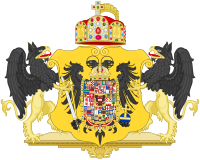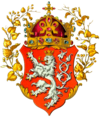Francis II, Holy Roman Emperor
| Francis II & I | |||||
|---|---|---|---|---|---|
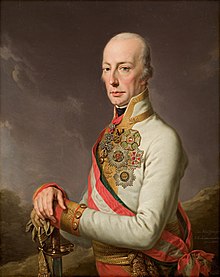 Portrait by Joseph Kreutzinger, c. 1815 | |||||
| Holy Roman Emperor | |||||
| Reign | 5 July 1792 – 6 August 1806 | ||||
| Coronation | 14 July 1792 Frankfurt Cathedral | ||||
| Predecessor | Leopold II | ||||
| Successor | Monarchy abolished (Napoleon as Protector of the Confederation of the Rhine) | ||||
| Governors (in Habsburg Netherlands) | See list
| ||||
Head of the Präsidialmacht Austria
| |||||
| In office 20 June 1815 – 2 March 1835 | |||||
| Succeeded by | Ferdinand I | ||||
| Born | 12 February 1768 Florence, Grand Duchy of Tuscany | ||||
| Died | 2 March 1835 (aged 67) Vienna, Austrian Empire | ||||
| Burial | |||||
| Spouses | Elisabeth of Württemberg (m. 1788; died 1790) | ||||
| Issue Detail |
| ||||
| |||||
Roman Catholicism | |||||
| Signature |  | ||||
Francis II and I (
The eldest son of future Emperor Leopold II and Maria Luisa of Spain, Francis was born in Florence, where his father ruled as Grand Duke of Tuscany. Leopold became Holy Roman Emperor in 1790 but died two years later, and Francis succeeded him. His empire immediately became embroiled in the French Revolutionary Wars, the first of which ended in Austrian defeat and the loss of the left bank of the Rhine to France. After another French victory in the War of the Second Coalition, Napoleon crowned himself Emperor of the French. In response, Francis assumed the title of Emperor of Austria. He continued his leading role as Napoleon's adversary in the Napoleonic Wars, and suffered successive defeats that greatly weakened Austria as a European power. In 1806, after Napoleon created the Confederation of the Rhine, Francis abdicated as Holy Roman Emperor, which in effect marked the dissolution of the Holy Roman Empire. Following the defeat of the Fifth Coalition, Francis ceded more territory to France and was forced to wed his daughter Marie Louise to Napoleon.
In 1813, Francis turned against Napoleon and finally defeated him in the War of the Sixth Coalition, forcing the French emperor to abdicate. Austria took part as a leading member of the Holy Alliance at the Congress of Vienna, which was largely dominated by Francis' chancellor Klemens von Metternich, culminating in a new European order and the restoration of most of Francis' ancient dominions. Due to the establishment of the Concert of Europe, which resisted popular nationalist and liberal tendencies, Francis was viewed as a reactionary later in his reign. Francis died in 1835 at the age of 67 and was succeeded by his son, Ferdinand I.
Early life

Francis was a son of
Emperor Joseph II himself took charge of Francis' development. His disciplinarian regime was a stark contrast to the indulgent Florentine Court of Leopold. The Emperor wrote that Francis was "stunted in growth", "backward in bodily dexterity and deportment", and "neither more nor less than a spoiled mother's child." Joseph concluded that "the manner in which he was treated for upwards of sixteen years could not but have confirmed him in the delusion that the preservation of his own person was the only thing of importance."[2]
Joseph's martinet method of improving the young Francis was "fear and unpleasantness."[3] The young Archduke was isolated, the reasoning being that this would make him more self-sufficient as it was felt by Joseph that Francis "failed to lead himself, to do his own thinking." Nonetheless, Francis greatly admired his uncle, if rather in fear of him. To complete his training, Francis was sent to join an army regiment in Hungary and he settled easily into the routine of military life.[4] He was present at the siege of Belgrade which occurred during the Austro-Turkish War.[5]
After the death of Joseph II in 1790, Francis' father became Emperor. He had an early taste of power while acting as Leopold's deputy in Vienna while the incoming Emperor traversed the Empire attempting to win back those alienated by his brother's policies.[6] The strain took a toll on Leopold and by the winter of 1791, he became ill. He gradually worsened throughout early 1792; on the afternoon of 1 March Leopold died, at the relatively young age of 44. Francis, just past his 24th birthday, was now Emperor, much sooner than he had expected.
Emperor
Wars with France
As the head of the
On 11 August 1804, in response to Napoleon crowning himself as emperor of the French earlier that year, he announced that he would henceforth assume the title of hereditary emperor of Austria as Francis I, a move that technically was illegal in terms of imperial law. Yet Napoleon had agreed beforehand and therefore it happened.[8][a]
Napoleonic Wars
During the
Five days later, Francis bowed to the inevitable and, without mentioning the ultimatum, affirmed that since the Peace of Pressburg he had tried his best to fulfil his duties as emperor but that circumstances had convinced him that he could no longer rule according to his oath of office, the formation of the Confederation of the Rhine making that impossible. He added that "we hereby decree that we regard the bond which until now tied us to the states of the Empire as dissolved"[12] in effect dissolving the empire. At the same time he declared the complete and formal withdrawal of his hereditary lands from imperial jurisdiction.[13] After that date, he reigned as Francis I, Emperor of Austria.

In 1809, Francis
In 1813, for the fifth and final time, Austria turned against France and joined
Domestic policy

The violent events of the French Revolution impressed themselves deeply into the mind of Francis (as well as all other European monarchs), and he came to distrust radicalism in any form. In 1794, a "

Francis was from his experiences suspicious and set up an extensive network of police spies and censors to monitor dissent
In military affairs Francis had allowed his brother, the
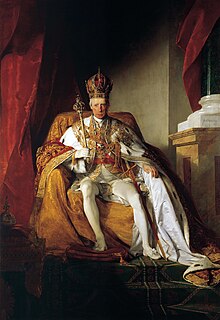
Francis presented himself as an open and approachable monarch (he regularly set aside two mornings each week to meet with his imperial subjects, regardless of status, by appointment in his office, even speaking to them in their own language),[23] but his will was sovereign. In 1804, he had no compunction about announcing that through his authority as Holy Roman Emperor, he declared he was now Emperor of Austria (at the time a geographical term that had little resonance). Two years later, Francis personally wound up the moribund Holy Roman Empire of the German Nation. Both actions were of dubious constitutional legality.[24]
To increase patriotic sentiment during the war with France, the anthem "Gott erhalte Franz den Kaiser" was composed in 1797 to be sung as the Kaiserhymne to music by Joseph Haydn.[25] The lyrics were adapted for later Emperors and the music lives on as the German national anthem "Deutschlandlied".
Death

On 2 March 1835, 43 years and a day after his father's death, Francis died in Vienna of a sudden fever aged 67, in the presence of many of his family and with all the religious comforts. Francis passed on a main point in the political testament he left for his son and heir Ferdinand: to "preserve unity in the family and regard it as one of the highest goods." In many portraits (particularly those painted by Peter Fendi) he was portrayed as the patriarch of a loving family, surrounded by his children and grandchildren.[26]
Marriages
Francis II married four times:
- On 6 January 1788, to Elisabeth of Württemberg(21 April 1767 – 18 February 1790).
- On 15 September 1790, to his double first cousin Maria Teresa of the Two Sicilies (6 June 1772 – 13 April 1807), daughter of King Ferdinand I of the Two Sicilies (both were grandchildren of Empress Maria Theresaand shared all of their other grandparents in common), with whom he had twelve children, of whom only seven reached adulthood.
- On 6 January 1808, he married again to another first cousin, .
- On 29 October 1816, to Karoline Charlotte Auguste of Bavaria (8 February 1792 – 9 February 1873) with no issue. She was daughter of Maximilian I Joseph of Bavaria and had been previously married to William I of Württemberg.
Children
From his first wife
| Name | Picture | Birth | Death | Notes |
|---|---|---|---|---|
| By Elisabeth of Württemberg | ||||
| Archduchess Ludovika Elisabeth | 18 February 1790 | 24 June 1791 (aged 1) | Died in infancy and buried in the Imperial Crypt, Vienna, Austria. | |
| By Maria Teresa of the Two Sicilies | ||||
| Archduchess Maria Ludovika | 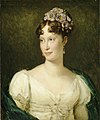 |
12 December 1791 | 17 December 1847 (aged 56) | Married first Adam, count of Neipperg , had issue, married third to Charles, Count of Bombelles, no issue.
|
| Emperor Ferdinand I |  |
19 April 1793 | 29 June 1875 (aged 82) | Married Maria Anna of Savoy, Princess of Sardinia, no issue. |
| Archduchess Marie Caroline | 8 June 1794 | 16 March 1795 (aged 9 months) | Died in childhood, no issue. | |
| Archduchess Caroline Ludovika | 22 December 1795 | 30 June 1797 (aged 1) | Died in childhood, no issue. | |
| Archduchess Caroline Josepha Leopoldine |  |
22 January 1797 | 11 December 1826 (aged 29) | Renamed Maria Leopoldina upon her marriage; married Pedro IV of Portugal); issue included Maria II of Portugal and Pedro II of Brazil .
|
| Archduchess Maria Klementina |  |
1 March 1798 | 3 September 1881 (aged 83) | Married her maternal uncle Leopold, Prince of Salerno, had issue. |
| Archduke Joseph Franz Leopold |  |
9 April 1799 | 30 June 1807 (aged 8) | Died some weeks after his mother in childhood, no issue. |
| Archduchess Maria Karolina |  |
8 April 1801 | 22 May 1832 (aged 31) | Married Crown Prince (later King) Frederick Augustus II of Saxony, no issue. |
| Archduke Franz Karl |  |
17 December 1802 | 8 March 1878 (aged 75) | Married Princess Sophie of Bavaria; issue included Franz Joseph I of Austria and Maximilian I of Mexico. |
Archduchess Marie Anne |
 |
8 June 1804 | 28 December 1858 (aged 54) | Born intellectually disabled (like her eldest brother, Emperor Ferdinand I) and to have suffered from a severe facial deformity. Died unmarried. |
| Archduke Johann Nepomuk | 30 August 1805 | 19 February 1809 (aged 3) | Died in childhood, no issue. | |
| Archduchess Amalie Theresa | 6 April 1807 | 9 April 1807 (aged 3 days) | Died in childhood, no issue. | |
Titles, honours and heraldry

Titles
From 1806 he used the titles: "We, Francis the First,
Orders and decorations
 Habsburg monarchy:
Habsburg monarchy:
- Knight of the Golden Fleece, 1768[30]
- Grand Cross of the Military Order of Maria Theresa, 1790[31]
- Founder and Grand Master of the Imperial Order of Leopold, 8 January 1808[32]
- Founder and Grand Master of the Imperial Order of the Iron Crown, 1815[32]
- France:
 French Empire: Grand Eagle of the Legion of Honour, 1811
French Empire: Grand Eagle of the Legion of Honour, 1811 Kingdom of France: Knight of the Holy Spirit, 1815[33]
Kingdom of France: Knight of the Holy Spirit, 1815[33]
 Knight of St. Hubert, 1813[34]
Knight of St. Hubert, 1813[34] Sweden: Grand Cross of the Sword, 1st Class, 20 February 1814[35]
Sweden: Grand Cross of the Sword, 1st Class, 20 February 1814[35] United Kingdom: Stranger Knight of the Garter, 9 June 1814[36]
United Kingdom: Stranger Knight of the Garter, 9 June 1814[36] Denmark: Knight of the Elephant, 12 November 1814[32]
Denmark: Knight of the Elephant, 12 November 1814[32] Kingdom of Portugal: Grand Cross of the Sash of the Three Orders, 1818[37]
Kingdom of Portugal: Grand Cross of the Sash of the Three Orders, 1818[37] Two Sicilies:
Two Sicilies:
 Kingdom of Sardinia: Knight of the Annunciation, 3 January 1824[39]
Kingdom of Sardinia: Knight of the Annunciation, 3 January 1824[39] Russian Empire:
Russian Empire:
- Knight of St. Andrew, 13 March 1826
- Knight of St. Alexander Nevsky, 13 March 1826
 Empire of Brazil:
Empire of Brazil:
- Grand Cross of the Order of Pedro I, 1827
- Grand Cross of the Southern Cross, 1830
 Baden:[40]
Baden:[40]
- Grand Cross of the House Order of Fidelity, 1830
- Grand Cross of the Zähringer Lion, 1830
 Grand Duchy of Tuscany: Grand Cross of St. Joseph
Grand Duchy of Tuscany: Grand Cross of St. Joseph
Heraldry
Ancestors
| Ancestors of Francis II, Holy Roman Emperor Maria Louisa of Spain | | |||||||||||||||
|---|---|---|---|---|---|---|---|---|---|---|---|---|---|---|---|---|
| 28. Augustus II of Poland | ||||||||||||||||
| 14. Augustus III of Poland | ||||||||||||||||
| 29. Christiane Eberhardine of Brandenburg | ||||||||||||||||
| 7. Maria Amalia of Saxony | ||||||||||||||||
| 30. Joseph I, Holy Roman Emperor | ||||||||||||||||
| 15. Maria Josepha of Austria | ||||||||||||||||
| 31. Wilhelmine Amalie of Brunswick | ||||||||||||||||
See also
- Family tree of the German monarchs
Notes
- ^ Later he was dubbed the first Doppelkaiser (double emperor) in history.[9]) For the two years between 1804 and 1806, Francis used the title and style by the Grace of God elected Roman Emperor, ever Augustus, hereditary Emperor of Austria and he was called the Emperor of both the Holy Roman Empire and Austria.
References
- ^ Wheatcroft 1996, p. 233
- ^ a b Wheatcroft 1996, p. 234
- ^ Wheatcroft 1996, p. 235
- ^ Wheatcroft 1996, p. 236
- ^ Malleson, George Bruce (1884). Loudon: A Sketch of the Military Life of Gideon Ernest, Freiherr von Loudon. London: Chapman & Hall. p. 229.
- ^ Wheatcroft 1996, p. 238
- ^ Fraser 2002, p. 492.
- OL 25339319M.
- ^ Posse 1909–1913, pp. 256.
- ^ Whaley 2012, p. 643.
- OL 4401178M.
- ^ Whaley 2012, p. 643–644.
- ^ Gagliardo 1980, p. 281.
- ^ Wheatcroft 1996, p. 249.
- ^ Wheatcroft 1996, p. 250.
- ^ Wheatcroft 1996, p. 239.
- ^ a b Wheatcroft 1996, p. 240.
- ^ Wheatcroft 1996, p. 234.
- ^ Wheatcroft 1996, p. 248.
- ^ Wheatcroft 1996, p. 241.
- ^ Rothenburg 1976, p. 6.
- ^ Rothenburg 1976, p. 10.
- ^ Wheatcroft 1996, p. 245.
- ^ Wheatcroft 1996, p. 246.
- OL 7653170M.
- ^ a b Wheatcroft 1996, p. 254
- ^ "Wien". Wiener Zeitung. 5 March 1835. p. 1, col. 2.
- ^ Wheatcroft 1996, p. 255
- ^ British and Foreign State Papers. H.M. Stationery Office. 1829.
- ^ Boettger, T. F. "Chevaliers de la Toisón d'Or – Knights of the Golden Fleece". La Confrérie Amicale. Retrieved 25 June 2019.
- ^ "Ritter-Orden: Militärischer Maria-Theresien-Orden", Hof- und Staats-Schematismus der ... Erzherzoglichen Haupt- und Residenzstadt Wien, 1791, p. 434, retrieved 13 September 2020
- ^ a b c J ..... -H ..... -Fr ..... Berlien (1846). Der Elephanten-Orden und seine Ritter. Berling. pp. 138–139.
- ^ Teulet, Alexandre (1863). "Liste chronologique des chevaliers de l'ordre du Saint-Esprit depuis son origine jusqu'à son extinction (1578–1830)" [Chronological list of knights of the Order of the Holy Spirit from its origin to its extinction (1578–1830)]. Annuaire-bulletin de la Société de l'histoire de France (in French) (2): 113. Retrieved 20 May 2020.
- ^ Hof- und Staatshandbuch des Königreichs Bayern: 1833. Landesamt. 1833. p. 6.
- ^ "Posttidningar, 30 April 1814". p. 2. Archived from the original on 22 February 2014. Retrieved 20 May 2020.
- ^ Shaw, Wm. A. (1906) The Knights of England, I, London, p. 51
- ISSN 0873-1330. Archived from the originalon 2 November 2014. Retrieved 17 March 2020.
- ^ Angelo Scordo, Vicende e personaggi dell'Insigne e reale Ordine di San Gennaro dalla sua fondazione alla fine del Regno delle Due Sicilie (PDF) (in Italian), p. 8, archived from the original (PDF) on 4 March 2016
- ^ Luigi Cibrario (1869). Notizia storica del nobilissimo ordine supremo della santissima Annunziata. Sunto degli statuti, catalogo dei cavalieri. Eredi Botta. p. 103.
- ^ Hof- und Staats-Handbuch des Großherzogtum Baden (1834), "Großherzogliche Orden" pp. 32, 50
- ^ Genealogie ascendante jusqu'au quatrieme degre inclusivement de tous les Rois et Princes de maisons souveraines de l'Europe actuellement vivans [Genealogy up to the fourth degree inclusive of all the Kings and Princes of sovereign houses of Europe currently living] (in French). Bourdeaux: Frederic Guillaume Birnstiel. 1768. p. 109.
Works cited
- ISBN 0-7538-1305-X.
- Posse, Otto, ed. (1909–1913). "OCLC 42197429 – via Wikisource.
- Rothenburg, Gunther E. (1976). The Army of Francis Joseph. West Lafayette, Ind.: Purdue University Press. ISBN 0911198415.
- Wheatcroft, Andrew (1996). The Habsburgs: Embodying Empire. London: Penguin Books. ISBN 0-14-023634-1.
Further reading
- Reich, Emil (1905). "Abidcation of Francis the Second". Select Documents Illustrating Mediæval and Modern History. Londong: P.S. King & Son. OCLC 4426595 – via Google Books.
- Reifenscheid, Richard (2006). Die Habsburger in Lebensbildern. Munich: Piper. ISBN 3492247539.
External links
- Spencer Napoleonica Collection Archived 5 December 2012 at archive.today at Newberry Library


